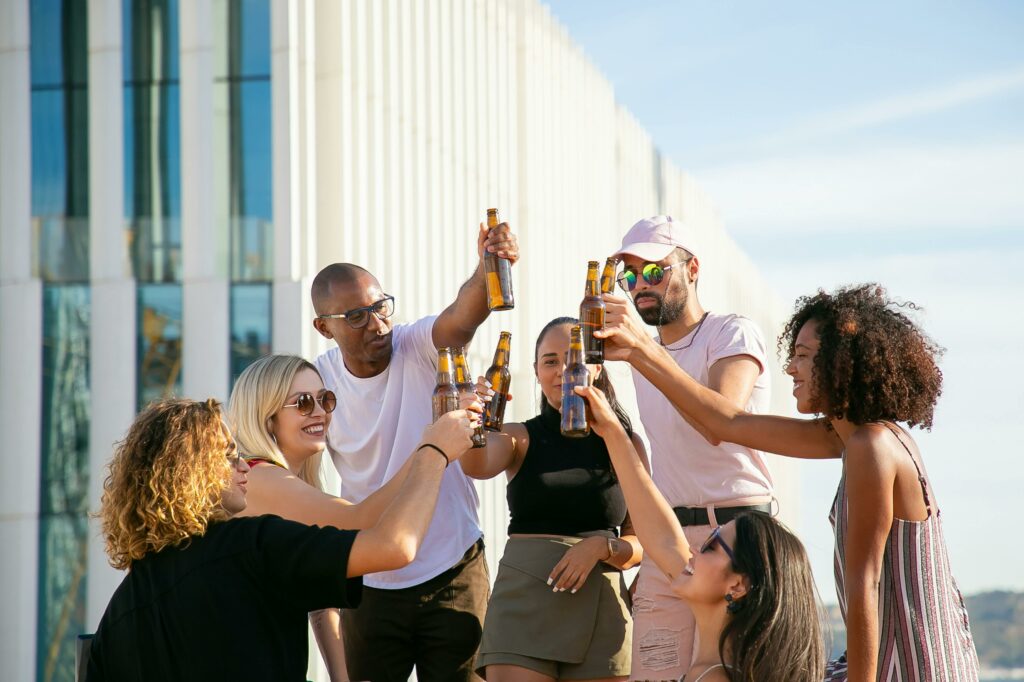
Did you know glass can be endlessly recycled without losing its quality? Brace yourself for more incredible facts as we dive into the world of sustainable sipping. The simple act of gathering your glass and placing it in one of our conveniently located purple bins can make a tangible impact on the environment, the economy, the community and – oh yes, you guessed it – the world. All that and more bubbly knowledge below!
Examples of Iconic Glass Bottle Designs
Just like Lucy with her zany schemes, we’re quickly moving on to the next history lesson. Here, we explore some all-stars that showcase the cultural impact of glass bottles:
- Fizz-tory Unleashed: In the 19th century, the Hutchinson bottle became a soda sensation with its unique spring stopper, creating a memorable “pop” when opened. It wasn’t just about containing soda; it held the drama, turning every fizzy sip into a mini celebration.
- Icon Status: Coca-Cola’s distinctive contour bottle, introduced in 1916, was not just a bottle, but a cultural icon! Beyond aesthetics, it served a practical purpose. Its curvaceous shape allowed it to be recognized even when shattered, reducing injuries for workers cleaning up broken glass.
- Hydration Elegance: Stepping into the world of premium water, the evian® Limited Edition Glass Bottle is a testament to elegance and sustainability. Launched periodically, these bottles are a fusion of artistry and environmental consciousness, adorned with unique designs from renowned artists to make it a collectible object.
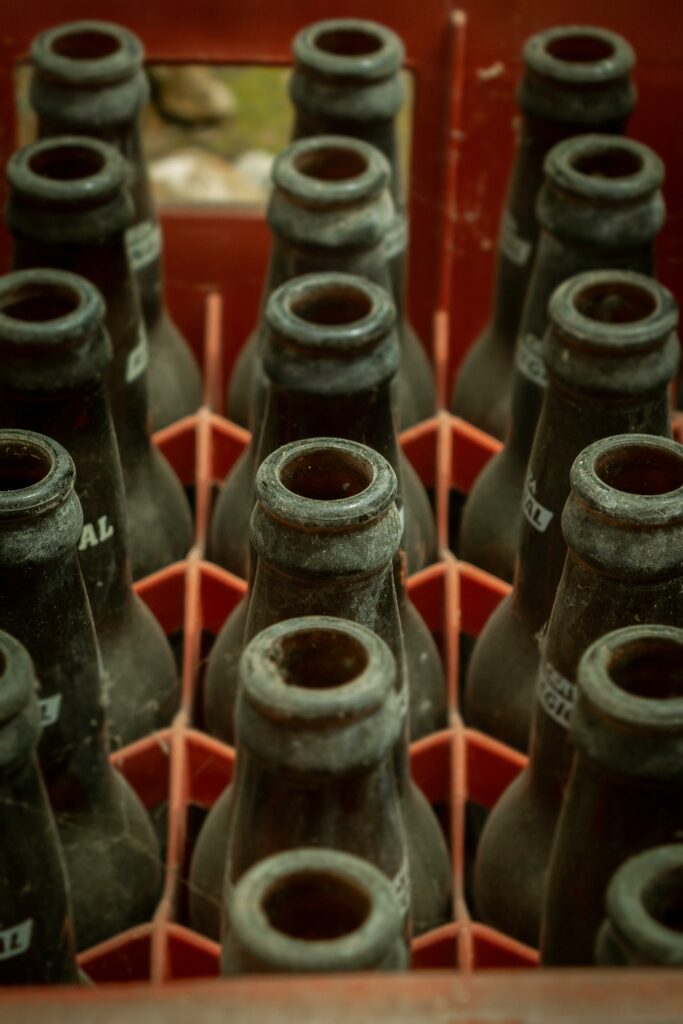
Why is Most Beer in Brown Glass Bottles?
Ever wondered why your favorite brew comes in brown bottles? Back in the mid-20th century, brewers had an “aha” moment – brown glass is like a bodyguard for beer. The amber hue acts as a shield to protect against UV light, keeping the flavor intact and the quality top-notch.
How Glass Beverage Bottles are Made
That glass bottle you’re holding isn’t just any bottle; it’s a blend of artistry, engineering and advanced technology crafted by a skilled team.
Who Makes Glass Bottles?
- Artisans: Skilled crafters transform sand, soda ash and limestone into recognizable containers.
- Engineers: Science experts manage the production line, overseeing the whole shebang from technology to blending ingredients to the final cooling of the product.
- Glass Factories: Big teams of crafters and tech whizzes join forces in giant factories to cook up those shiny glass wonders.
How are Glass Bottles Made?
- Collection from Recycling Bins: It all begins with you! When you toss your glass into one of our purple bins, it sets off an extraordinary process that gives your glass a second life.
- Transportation to Recycling Facility: Specially designed trucks, like recycling chariots, carry the recycled glass to our specialized facility.
- Sorting and Removal of Contaminants: Careful sorting removes impurities, allowing only pure, high-quality glass to move forward.
- Crushing and Cleaning: Glass is skillfully crushed and cleaned, turning it into fine sand or “cullet.”
- Formation of New Glass Products: The exciting finish line involves Ripple Glass sending cullet to manufacturers to create new fiberglass insulation and glass bottles.
How Does Glass Bottle Production Compare to Other Packaging Materials?
When it comes to sustainability, glass bottles shine as eco-warriors in a competitive arena. Here’s why:
- Endless Recyclability: Glass is the only material that can be recycled endlessly without losing quality and purity.
- Lower Environmental Impact: Glass bottle production has a smaller environmental footprint than plastic and metal, emitting fewer greenhouse gases.
- Circular Economy Contribution: Perhaps most crucially, glass bottles actively contribute to a circular economy, seamlessly being recycled and reincarnated into new bottles indefinitely – a feat that plastic struggles to achieve.
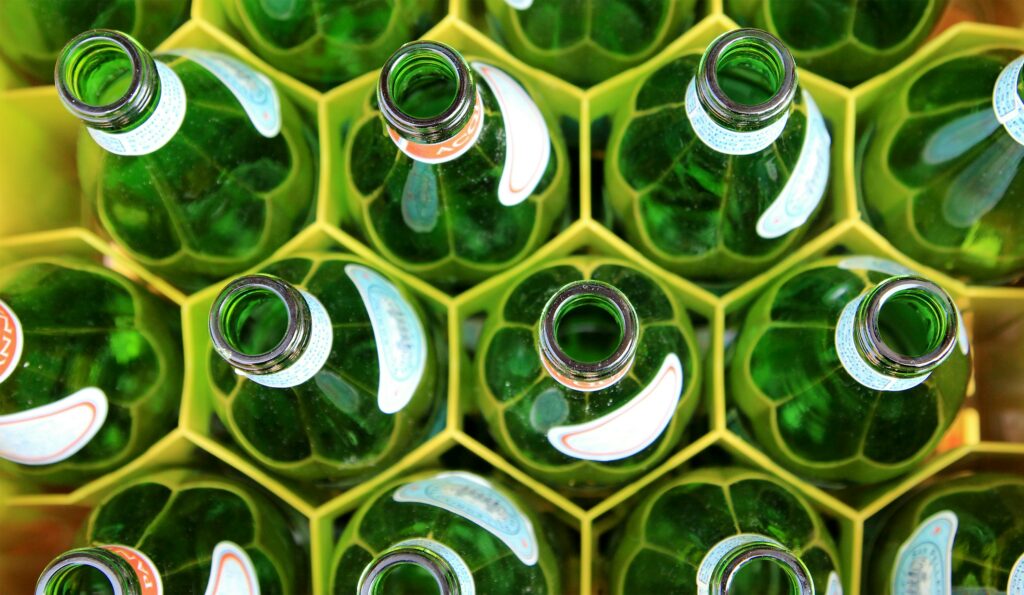
Recycling Bottles to Make New Glass Beverage Bottles
Wondering about your bottle’s fate in the recycling bin? Fear not – it embarks on a magical journey, transforming into brand-new beginnings.
Glass Recycling Process: Can Glass Bottles Be Recycled Indefinitely?
Yes! Glass is the Muhammad Ali of packaging materials – it doesn’t throw in the towel after a few rounds. Imagine a never-ending cycle of rebirth and endless recyclability.
The Benefits of Glass Recycling: Environmental Advantages and Resource Conservation
Choosing recycled glass is a win-win-win! It saves resources by avoiding new material extraction, cuts energy use significantly and reduces air pollution from traditional glass production. It’s a simple choice for a cleaner, greener planet.
Emerging Technologies for Improving Glass Recycling
The Ripple Glass processing plant currently uses optical sorters and advanced technology to remove non-glass items and separate glass by color. But recycling technology continues to evolve quickly! In several recycling facilities worldwide, advanced sorting systems that use robotic arms and Artificial Intelligence (AI) have already been implemented. As AI innovations continue to develop, they could potentially impact the glass recycling space more directly in the future.
Creative and Alternative Uses for Recycled Glass Bottles
Once the glass bottle has done its duty as a container, its journey is far from over. Recycled glass bottles have diverse applications, including:
- New Bottles: Recycled glass is utilized in the manufacturing process of new glass bottles, reducing the need for raw materials and energy consumption in glass production.
- Fiberglass Insulation: Glass bottles are transformed into fiberglass insulation, enhancing energy efficiency in homes and buildings by providing effective insulation.
- Eco-Friendly Design: Recycled glass plays a role in sustainable home design, contributing to eco-friendly countertops and décor, promoting a greener approach to interior spaces.
- Construction: Crushed glass is incorporated into concrete and construction materials, offering a sustainable alternative and reducing the environmental impact of building projects.
- Art: Artists repurpose glass bottles for sculptures and decorative pieces, showcasing the aesthetic potential of recycled materials in the art world.
- Filtration: Crushed glass finds application in water treatment as a filtering medium, effectively removing impurities and contributing to sustainable filtration solutions.
- Countertops, Flooring, Tiles: Recycled glass is used in the production of eco-friendly surfaces, such as countertops, flooring and tiles, adding a touch of sustainability to interior design.
- Fiberglass Countertops: Recycled glass is combined with binders to create lightweight and durable fiberglass countertops, providing a sustainable and stylish alternative for kitchen and bathroom surfaces.
Give Glass a Second Life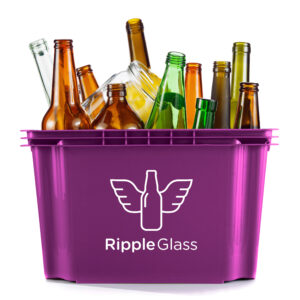
As we toast to a brighter future, the call to action is simple – join the glass-recycling movement, locate a purple bin and contribute to a cleaner, greener planet. With over a billion glass bottles rescued since 2009, our call to act is clear: sip, recycle, repeat for a sustainable tomorrow. Find a purple bin near you and join our community of Ripple Makers today!
